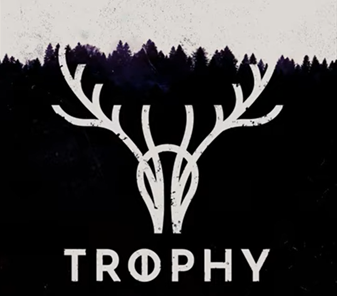Winner of the 2023 Silver ENNIE award for best game, Trophy Dark is a tragic fantasy storytelling game where treasure-hunters enter a haunted forest that doesn’t want them there. It is not a story of heroes, but rather, of flawed and desperate characters seeking hidden riches in order to reclaim that which they have already lost. While many fantasy role-playing games focus on the hero’s triumph, Trophy Dark has its eyes squarely on the fool’s demise.

This idea allows the players to create a different kind of story. Not a D&D story, where heros find the path to power and glory laid at their feet, or where the evils of the world can be vanquished by a ragtag group of rascals. We’re talking about stories like The Statement of Randolph Carter (Lovecraft), Klara and the Sun (Ishiguro), The Duchess of Malfi (Webster), King Lear (Shakespeare), and Disgrace (J.M Coetzee). Stories that are profound, but which hurt. Stories that make you wonder why and set your head spinning. Stories that make you think. Stories that stay with you long after the book has been read.

To this end, the ruleset (adapted from Cthulhu Dark) is simple, elegant, and brutal. There is only one statistic, Ruin, which tracks the character’s path to oblivion. As ruin increases, the forest increasingly sinks its claws into you. Moss may start growing under your skin, or you may become increasingly paranoid, for example. When your ruin score gets really high, you can reduce it by acting in the interests of the forest (and against your fellow players). Attempting to do difficult tasks requires a ‘Risk roll’ of one or more six-sided dice. Accepting the possibility of a super-negative result (a ‘devil’s bargain’) or an increased ruin score gives you more dice to roll, and you just choose the highest score. A 1-3 is a failure, 4-5 is a success with a negative consequence, and a 6 is a full success. If you fight a creature of the forest, you die: your only real options are to run or hide.
The Devil’s bargain mechanic encourages risk-taking by offering a bonus die to players who accept a negative consequence for failing the roll. This bargain can be offered by other players or the GM, but it’s up to the individual whether they accept or not.
So, yeah, the players are set up to fail. But the question is this: can it be done in style? Will you tell the tale of a wealthy noble who lost it all at the gambling table, a hopeless romantic searching for a missing loved one, or a scoundrel seeking redemption? The point is that you have characters desperate or foolhardy enough to face almost-dertain doom to get what they want. Most games start near the beginning of a character’s story. This game describes the final chapter.
Beyond failure, the game is also about betrayal. The risk reduction mechanic encourages players who are on their way out to betray their fellows by acting in the interests of the forest. While this kind of behaviour violates the social contract in cooperative heroic fantasy games, in Trophy Dark the social contract involves cooperation in the telling of a tragic story. It’s a different type of fun, a kind of celebration of the awful.
Character creation is quick and simple, with players rolling for or choosing names, backgrounds (including skills), motivations (called Drives), and rituals; dangerous spells that enable characters to achieve miraculous results. Sometimes.

The world in which the game is played is described in broad terms, enabling the players to define a great deal of it themselves. The Forest is a generic term to describe a cursed or blighted area abandoned by humanity, but which hides objects of great value. It could be a marsh, an abandoned city, or even the sea. It doesn’t matter. What matters is that humans have plundered it’s resources and stolen its secrets, and it wants them gone.
Gameplay is highly collaborative, with players describing just as much of the world and the events in it as the GM. This takes out the sting of the many misfortunes players experience, as they get to decide what happens as a result of a bad dice roll, and describe it themselves, rather than the GM. In the same vein, the setting book, Trophy Loom, provides endless tables with details and story threads for the GM and players to improvise on during the game. The idea is that the setting is organic, flexible, and different for every group. But one thing is constant: there is a forest called the Kaldur, and it wants to kill you. There are no heroes seeking glory, just Treasure Hunters desperate for coin: poor folk, fallen aristocracy, outsiders, the lost.

This is not a game of victory and triumph, but one of desperation and loss. But it is the players who describe their decline, the terms on which they bow out and the meaning (if any) of their demise. What results is are stories that are dark, compelling, and often bittersweet.
Check out our review of Trophy Loom
Get it here: https://preview.drivethrurpg.com/en/product/402818/trophy-dark
Check out the community content on itch.io
Check out Trophy Dark playthroughs on YouTube

Leave a Reply
You must be logged in to post a comment.